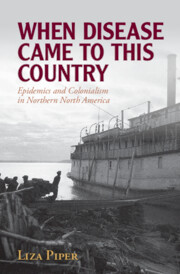148 results
3 - Inuit Nunangat and the Blue Pacific
- from Part I - Geographies of Environmental Violence
-
-
- Book:
- Exploring Environmental Violence
- Print publication:
- 30 June 2024, pp 63-83
-
- Chapter
-
- You have access
- Open access
- HTML
- Export citation
Scoping Arctic expertise: The mismatch between traditional theories of expertise and Indigenous expertise
-
- Journal:
- Polar Record / Volume 60 / 2024
- Published online by Cambridge University Press:
- 29 April 2024, e12
-
- Article
-
- You have access
- Open access
- HTML
- Export citation
On the effects of the timing of an intense cyclone on summertime sea-ice evolution in the Arctic
-
- Journal:
- Annals of Glaciology , First View
- Published online by Cambridge University Press:
- 15 April 2024, pp. 1-15
-
- Article
-
- You have access
- Open access
- HTML
- Export citation
Quantifying the impact of X-band InSAR penetration bias on elevation change and mass balance estimation
-
- Journal:
- Annals of Glaciology , First View
- Published online by Cambridge University Press:
- 05 February 2024, pp. 1-15
-
- Article
-
- You have access
- Open access
- HTML
- Export citation
Fishy windows to an Arctic city: Urban (in)visibilities of global fisheries in Tromsø
-
- Journal:
- Polar Record / Volume 60 / 2024
- Published online by Cambridge University Press:
- 04 January 2024, e2
-
- Article
-
- You have access
- Open access
- HTML
- Export citation
1 - Introducing Dynamic Sustainability
- from Part I - Introduction and Global Trends
-
- Book:
- Dynamic Sustainability
- Published online:
- 07 December 2023
- Print publication:
- 21 December 2023, pp 3-14
-
- Chapter
- Export citation
Thomas Blanky (1804–1848/51?)
-
- Journal:
- Polar Record / Volume 59 / 2023
- Published online by Cambridge University Press:
- 01 December 2023, e38
-
- Article
-
- You have access
- Open access
- HTML
- Export citation
Can China change the Arctic regime?
-
- Journal:
- Polar Record / Volume 59 / 2023
- Published online by Cambridge University Press:
- 18 October 2023, e33
-
- Article
-
- You have access
- Open access
- HTML
- Export citation
Russia’s Arctic policy: Upcoming change?
-
- Journal:
- Polar Record / Volume 59 / 2023
- Published online by Cambridge University Press:
- 29 September 2023, e31
-
- Article
- Export citation
Sŭ-pung-er’s pillar: The recent significant discovery of a relic related to the Franklin Expedition
-
- Journal:
- Polar Record / Volume 59 / 2023
- Published online by Cambridge University Press:
- 08 September 2023, e29
-
- Article
-
- You have access
- Open access
- HTML
- Export citation
10 - Epilogue and Conclusions
-
- Book:
- When Disease Came to This Country
- Published online:
- 20 July 2023
- Print publication:
- 10 August 2023, pp 293-306
-
- Chapter
- Export citation
12 - The Arctic Sublime
- from Part II - Romantic Sublimes
-
-
- Book:
- The Cambridge Companion to the Romantic Sublime
- Published online:
- 06 July 2023
- Print publication:
- 20 July 2023, pp 154-165
-
- Chapter
- Export citation

When Disease Came to This Country
- Epidemics and Colonialism in Northern North America
-
- Published online:
- 20 July 2023
- Print publication:
- 10 August 2023
Arctic science diplomacy in new geopolitical conditions: From “soft” power to “hard” dialogue?
-
- Journal:
- Polar Record / Volume 59 / 2023
- Published online by Cambridge University Press:
- 19 July 2023, e23
-
- Article
- Export citation
5 - Greenland’s Fall and Restoration
-
- Book:
- The Vanished Settlers of Greenland
- Published online:
- 01 June 2023
- Print publication:
- 06 July 2023, pp 181-214
-
- Chapter
- Export citation
2 - Greenland and Discourses of Possession
-
- Book:
- The Vanished Settlers of Greenland
- Published online:
- 01 June 2023
- Print publication:
- 06 July 2023, pp 65-102
-
- Chapter
- Export citation
Mental maps, practical mastery and environmental experience: an analysis of the wayfinding culture of Evenki reindeer herders and hunters
-
- Journal:
- The Journal of Navigation / Volume 76 / Issue 4-5 / July 2023
- Published online by Cambridge University Press:
- 26 January 2024, pp. 590-601
- Print publication:
- July 2023
-
- Article
-
- You have access
- Open access
- HTML
- Export citation
Massive ground ice of glacial meltwater origin in raised marine-deltaic sediments, Fosheim Peninsula, high Arctic Canada
-
- Journal:
- Quaternary Research / Volume 116 / November 2023
- Published online by Cambridge University Press:
- 22 June 2023, pp. 96-107
-
- Article
-
- You have access
- Open access
- HTML
- Export citation
14 - Canada and the High Arctic Islands, 1880–1950
-
-
- Book:
- The Cambridge History of the Polar Regions
- Published online:
- 24 March 2023
- Print publication:
- 11 May 2023, pp 325-353
-
- Chapter
- Export citation
16 - Industrial Whaling in the Arctic and Antarctic
-
-
- Book:
- The Cambridge History of the Polar Regions
- Published online:
- 24 March 2023
- Print publication:
- 11 May 2023, pp 378-406
-
- Chapter
- Export citation



